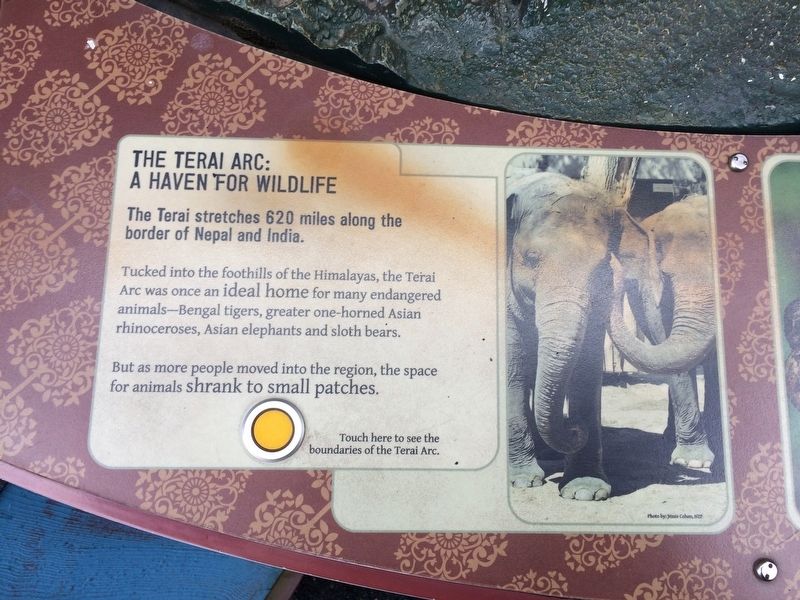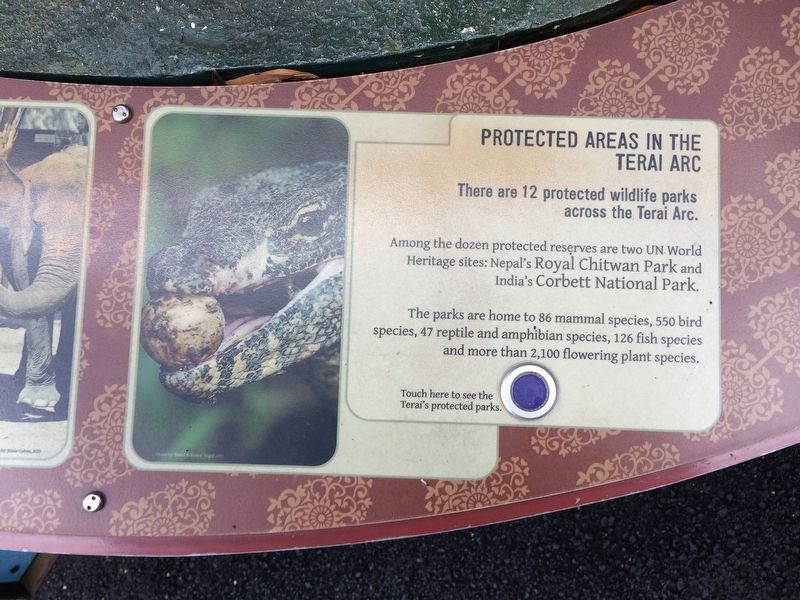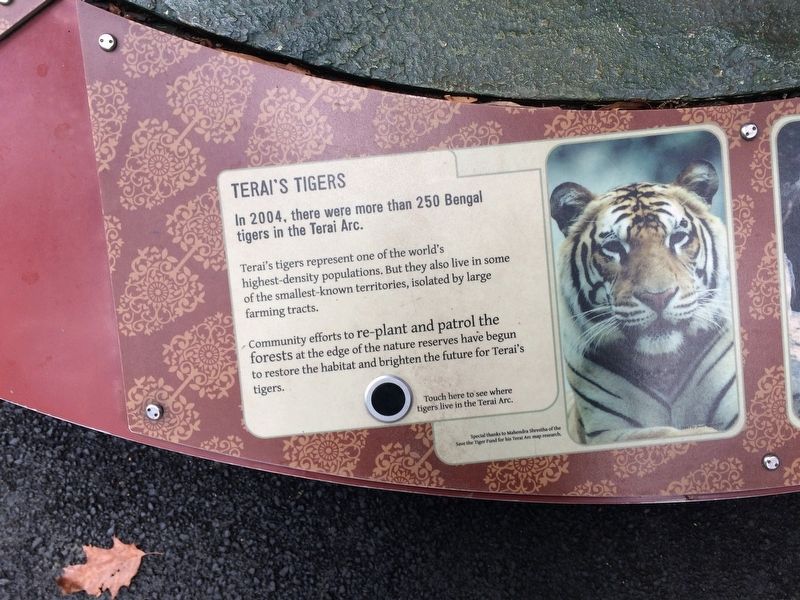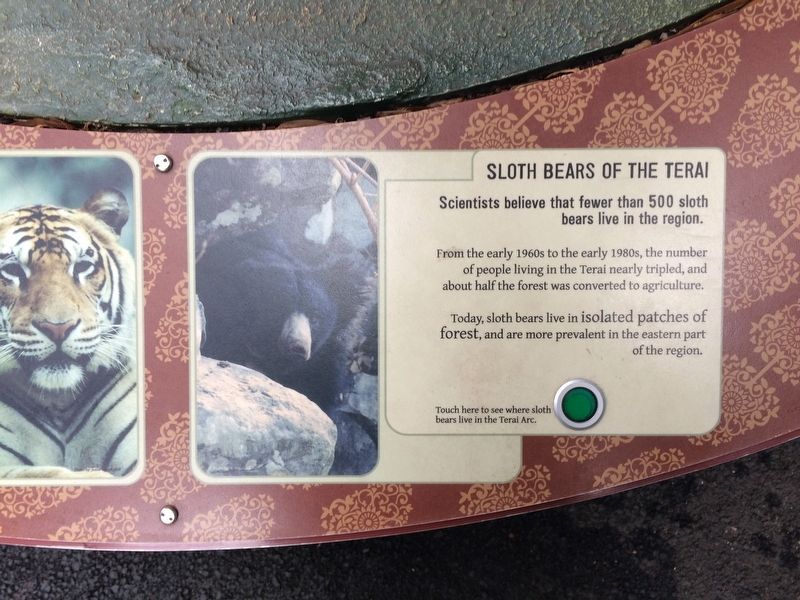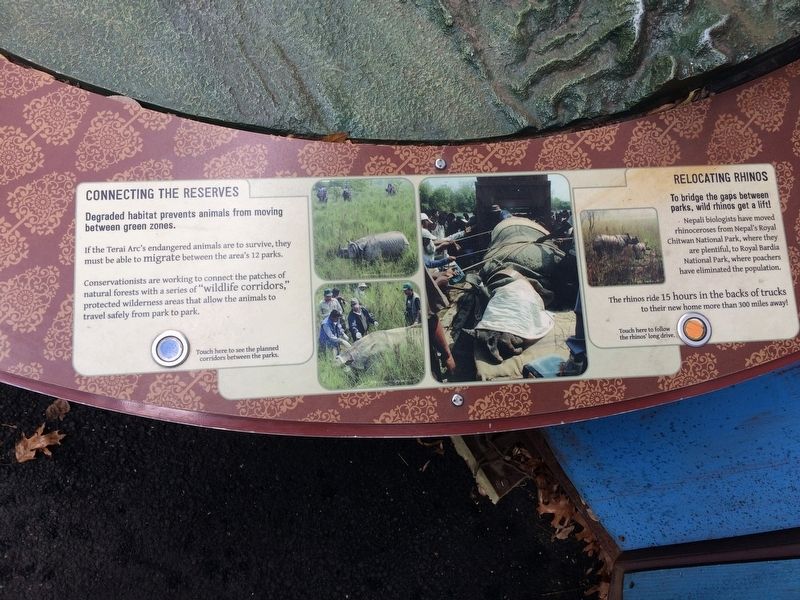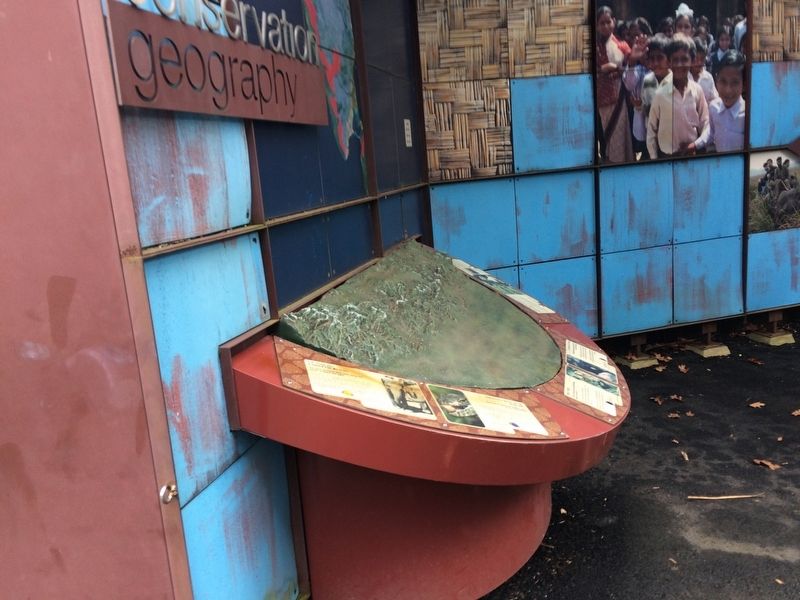Smithsonian National Zoo in Northwest Washington in Washington, District of Columbia — The American Northeast (Mid-Atlantic)
Conservation Geography
First panel from the left:
The Terai Arc:
A Haven for Wildlife
The Terai stretches 620 miles along the border of Nepal and India.
Tucked into the foothills of the Himalayas, the Terai Arc was once an ideal home for many endangered animals—Bengal tigers, greater one-horned Asian rhinoceroses, Asian elephants and sloth bears.
But as more people moved into the region, the space for animals shrank to small patches.
Touch here to see the boundaries of the Terai Arc.
Caption on image:
Photo by: Jessie Cohen, NZP
Second panel from the left:
Protected Areas in the Terai Arc
There are 12 protected wildlife parks across the Terai Arc.
Among the dozen protected reserves are two UN World heritage sites: Nepal's Royal Chitwan Park and India's Corbett National Park.
The parks are home to 86 mammal species, 550 bird species, 47 reptile species, and amphibious species, 126 fish species and more than 2,100 flowering plant species.
Touch here to see the Terai's protected parks.
Caption on image:
Photo by: David Behrens, August 2002.
Third panel from the left:
Terai's Tigers
In 2004, there were more than 250 Bengal tigers in the Terai Arc.
Terai's tigers represent one of the world's highest-density populations. But they also live in some of the smallest-known territories, isolated by large farming tracts.
Community efforts to re-plant and patrol the forests at the edge of the nature reserves have begun to restore the habitat and brighten the future for Terai's tigers.
Touch here to see where tigers live in the Terai Arc.
Caption on image:
Special thanks to Mahendra Shrestha of the Save the Tiger Fund for his Terai Arc map research.
Fourth panel from the left:
Sloth Bears of the Terai
Scientists believe that fewer than 500 sloth bears live in the region.
From the early 1960s to the early 1980s, the number of people living in the Terai nearly tripled, and about half the forest was converted to agriculture.
Today, sloth bears live in isolated patches of forest, and are more prevalent in the eastern part of the region.
Touch here to see where sloth bears live in the Terai Arc.
Caption from image:
Photograph: K. Yuganand
Fifth panel from the left:
Connecting the Reserves
Degraded habitat prevents animals from moving between green zones.
If the Terai Arc's
Conservationists are working to connect the patches of national forests with a series of "wildlife corridors," protected wilderness areas that allow the animals to travel safely from park to park.
Touch here to see the planned corridors between the parks.
Sixth panel from the left:
Relocating Rhinos
To bridge the gaps between parks, wild rhinos get a lift!
Nepali biologists have moved rhinoceroses from Nepal's Royal Chitwan National Park, where they are plentiful, to Royal Bardia National Park, where poachers have eliminated the population.
The rhinos ride 15 hours in the backs of trucks to their new home more than 300 miles away!
Touch here to follow the rhinos' long drive.
Erected by Smithsonian Institution.
Topics. This historical marker is listed in these topic lists: Animals • Environment. A significant historical year for this entry is 1960.
Location. 38° 55.806′ N, 77° 3.236′ W. Marker is in Northwest Washington in Washington, District of Columbia. It is in Smithsonian National Zoo. Marker is on Olmstead Walk. On the grounds of the Smithsonian National Zoological Park. Touch for map
Other nearby markers. At least 8 other markers are within walking distance of this marker. Sloth Bear (a few steps from this marker); Fishing Cat (a few steps from this marker); Anup Joshi (a few steps from this marker); Saving Species Through Science (within shouting distance of this marker); Max Kampelman (within shouting distance of this marker); Red Pandas (about 300 feet away, measured in a direct line); Farmers and Felines (about 300 feet away); Optimism for the Oryx (about 300 feet away). Touch for a list and map of all markers in Northwest Washington.
Credits. This page was last revised on January 30, 2023. It was originally submitted on December 17, 2017, by Devry Becker Jones of Washington, District of Columbia. This page has been viewed 143 times since then and 10 times this year. Photos: 1, 2, 3, 4, 5, 6. submitted on December 17, 2017, by Devry Becker Jones of Washington, District of Columbia. • Bill Pfingsten was the editor who published this page.
